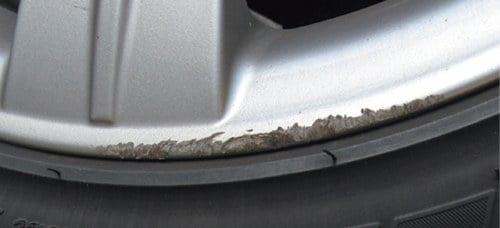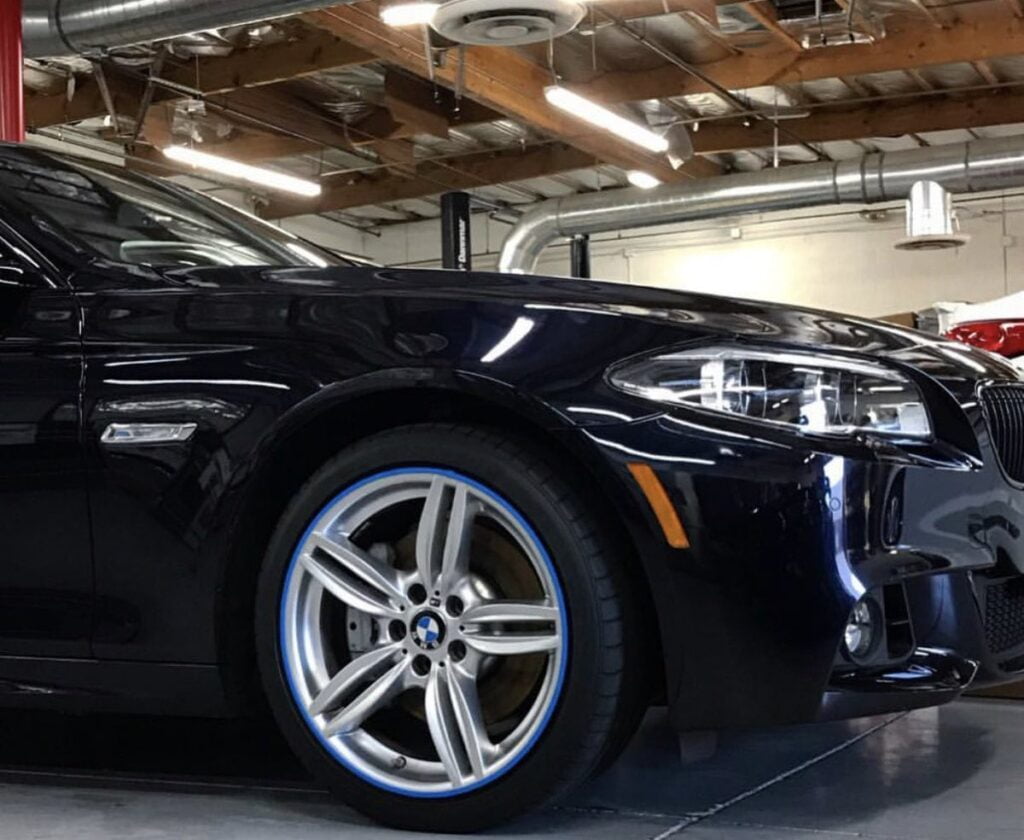During the lifetime of a car, the wheels are probably the most vulnerable to damage. Most commonly, damage can happen when drivers accidentally hit a curb when making a tight turn or when attempting parallel parking.
In the following few minutes we will walk you through how you can avoid curb rashes and protect your wheels and your wallet from an expensive repair. If you want to avoid a wheel damage or you already had one here are some tips for keeping your wheels in mint condition.

1. Pay Attention at Parallel Parking
Like mention before, parking is probably the most common cause of curb rash. It’s that annoying moment, when you are in a hurry to park and suddenly you hear the metal touching the concrete, a sound many drivers who really care about their cars would like to never hear or experience.
Many drivers who aren’t used to parallel parking will hit the curb when attempting to park, especially if the driver attempts the maneuver with the front of the car. If you haven’t mastered the art of parallel parking, try practicing in an empty parking lot with wide open spaces until you feel confident, and can make the maneuver in one move. Here’s a guide on parallel parking.
On the other hand, curb rash happens a lot in case of newly bought vehicles, when the owner is still trying to get a sense of the cars size. The issue here is the moment of over confidence when the driver thinks he feels the size of the car, but truth is that he or she doesn’t and this over confidence will get drivers in trouble, ending up with a curb rash or even worse a dent or a serious accident. Be humble, drive safe!
Few things can be more frustrating than attempting to parallel park and hitting a curb. It can cost you hundreds or more on repairs!
2. Prepare Your Wheels For The Season
Different weather conditions can be tough on your wheels. In winter slippery ice-covered roads can cause your car to slide into a curb. It’s needless to say that every driver facing a winter season should immediately change to winter tires, to be more exact it is recommended to switch to winter tires, when the seasonal temperature falls below 7 °C (46 °F). Winter tires have better grip and traction in icy conditions, thus giving the car better handling.
Another factor that contributes to rim damage during the winter months is road salt. Mixed with melting ice and snow, salt becomes salt water, which eats away your wheels. It’s important to wash your wheels often during winter months. Tip: Before washing your wheel make sure you give a few minutes for your breaks to cool off, and try to avoid washing your wheels with cold water.
3. Install Wheel Rim Protectors
Many drivers are particularly fond about their cars and the looks of their cars, that’s why many are looking for ways to shield their alloy wheels from potential damage. Many are choosing to install alloy wheel rim protectors, which in essence is designed to give a protective layer to the edges of alloy wheels, to prevent damage. One of the best ways to keep your vehicle’s wheels protected from curb rash is to install wheel rim protectors. Rim protectors are a great design, to keep rims safe from damage. Many argue that wheel rims will have a bad effect on the car’s overall look, however opinions vary and everyone can find a rim protector in a color that best matches their cars overall look. Decide for yourself!
What are alloy wheel rim protectors?
They are a strip of flexible, tough plastic or rubber that fits around the edge of the alloy wheel rims. Some protectors are self-adhesive, sticking over the edge of the wheel. Others slot between the wheel and the tire.
Alloy wheel rim protectors protect the edges or rims of your alloy wheels. Some do this by covering the edges, while others provide a slight protrusion that takes the hit of any contact. The basic idea is that if you do scratch your wheels, the rim protector is absorbing the damage, keeping your wheels rims untouched.
Wheel Rim protectors come in a range of colors. Black can make the tire look larger while silver makes the alloy wheel look wider. They are also available in a selection of bright colors to provide a ring of color around the wheel.
Which rim protectors should I get?
There are two main kinds of alloy wheel rim protectors:
- Alloygators are made of tough flexible plastic is slot between the wheel and the tire. They are more expensive to buy, and need craftsmanship for fitting. But, they are the best choice if you are looking for a more durable option that doesn’t depend on an adhesive to stay in place.
- Self-adhesive rim protectors, such as RimBlades stick over the edge of the alloy wheels. These are essentially a cheaper option and with minimal skill anyone can fit them easily at home. As they are rubber, these types of protectors will not withstand as much damage.
Self-adhesive wheel rim protectors also come in different types. Depending on the shape of your alloy wheels, some fit wheels with rounded and curved rims, while others are designed for flat edges.
It is not recommended that you use wheel rim protectors on alloy wheels that are diamond cut or have a lacquer/paint finish. If you’re not sure what kind of alloy wheels you have, ask a local garage or fitting specialist for advice or in case you have a BMW you can browse our list the of BMW wheels.
How to fit the rim protector will depend on the type of protector and wheel you have. If they are slot between the wheel and the tire, like Alloygators, they will need professional fitting or a bit more craftsmanship from your side. It’s not a complicated process, but it takes some time and tools, as the car needs to be lifted and the tire needs deflating for the fitting to take place. If you fancy some do it your self-project, this can be a great weekend afternoon occupation, but keep in mind to read the fitting guide on Alloygator’s website. On the other hand adhesive alloy protectors, like Rimblades, can be fitted more easily with less hassle at home.

How to fit self-adhesive rim protectors
Installing self-adhesive wheel rim protectors is a fairly easy task and takes little time to apply. They are available in many different colors to match the look of your vehicle, and they can appear as more than a simple protective measure, but also as a cool accessory. (Opinions vary)
Start by jacking up the car, so you can spin the wheel around as you work. Make sure you try to fit the wheel rim protector in warm conditions for easier installing.
- First, clean the alloy wheel using a sponge and soapy water. Any residue or contaminants will affect the glue.
- Wipe using alcohol any remaining residue from the edge of the wheels. Leave to dry for one minute.
- Apply the primer (if provided) around the full circumference of the wheel. Leave this to dry for 5 to 20 minutes.
- Peel the backing tape off the first few inches of the rim protector. Stick the first few inches firmly on to the edge of the wheel. Continue to peel and stick the strip down in sections, all the way around the wheel.
- Once reached the starting point, let the product overlap and leave the last inch of backing tape on. Mark the joining point and cut the protective strip to size, so it will fit together.
- Peel and stick the end down. You can use a drop of superglue to attach the ends together.
- Check around the wheel, pushing hard on the rim protector strip. This will help bond the protector with the wheel.
- Leave to cure for at least 24 hours; it can take up to 72 hours before it is completely safe to drive.
- If you need to remove the protectors, pull off at a 45-degree angle. Soak any adhesive residue in WD40 and heat it up to remove it.
Another benefit of wheel rim protectors is the fact that car owners can easily detach them whenever they need to, whether to clean the protector or the wheel, or to change the wheel and tire. Car owners can then reattach them as easily when they want to use them again.
4. Sprayable Vinyl Paint Protection Film
Another great way to protect your wheels, is applying a sprayable vinyl paint protection film on your wheels. Products like LiquidShield are offering a paint protection film to protect wheels and accessories on your car with a high gloss, smooth and invisible film. This solution however will only protect your wheels from light scratches, rock chips, debris, UV damage, chemicals and other elements found in daily driving environments. It’s an adhesive free solution making removal safe for OEM clear coated paint and metal surfaces. The absence of adhesive also keeps the film from yellowing or discoloring over time.
As a conclusion there are various options to consider when it comes to protecting your wheels, however best prevention is the mindfulness when parking and taking tight corners, all other options are there to mitigate risk of damage to a certain extent.

